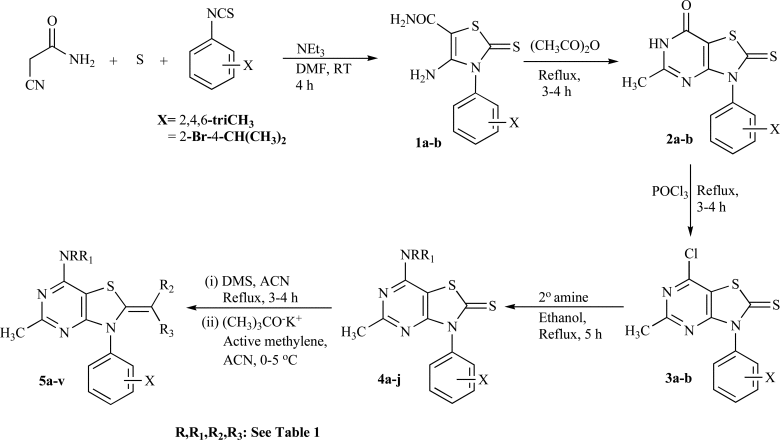Synthesis of new thiazolo[4,5-d]pyrimidines as Corticotropin releasing factor modulators
- PMID: 25059547
- PMCID: PMC4462850
- DOI: 10.2174/1573406410666140724115627
Synthesis of new thiazolo[4,5-d]pyrimidines as Corticotropin releasing factor modulators
Abstract
Corticotropin-releasing factor (CRF) is a neurohormone that plays a crucial role in integrating the body's overall response to stress. It appears necessary and sufficient for the organism to mount functional, physiological and endocrine responses to stressors. CRF is released in response to various triggers such as chronic stress. The role of CRF and its involvement in these neurological disorders suggest that new drugs that can target the CRF function or bind to its receptors may represent a new development of neuropsychiatric medicines to treat various stress-related disorders including depression, anxiety and addictive disorders. Based on pharmacophore of the CRF1 receptor antagonists, a new series of thiazolo[4,5-d] pyrimidines were synthesized as Corticotropin-releasing factor (CRF) receptor modulators and the prepared compounds carry groups shown to produce optimum binding affinity to CRF receptors. Twenty two compounds were evaluated for their CRF1 receptor binding affinity in HEK 293 cell lines and two compounds 5o and 5s showed approximately 25% binding affinity to CRF1 receptors. Selected compounds (5c and 5f) were also evaluated for their effect on expression of genes associated with depression and anxiety disorders such as CRF1, CREB1, MAO-A, SERT, NPY, DatSLC6a3, and DBH and significant upregulation of CRF1 mRNA has been observed with compound 5c.
Figures





Similar articles
-
Design, Synthesis, and Biological Evaluations of Novel Thiazolo[4,5-d]pyrimidine Corticotropin Releasing Factor (CRF) Receptor Antagonists as Potential Treatments for Stress Related Disorders and Congenital Adrenal Hyperplasia (CAH).Molecules. 2024 Aug 1;29(15):3647. doi: 10.3390/molecules29153647. Molecules. 2024. PMID: 39125051 Free PMC article.
-
Synthesis of substituted pyrimidines as corticotropin releasing factor (CRF) receptor ligands.Eur J Med Chem. 2014 May 6;78:1-9. doi: 10.1016/j.ejmech.2014.03.040. Epub 2014 Mar 15. Eur J Med Chem. 2014. PMID: 24675175
-
Selective antagonism of CRF1 receptor by a substituted pyrimidine.Hormones (Athens). 2019 Jun;18(2):215-221. doi: 10.1007/s42000-019-00105-9. Epub 2019 Apr 12. Hormones (Athens). 2019. PMID: 30980254
-
Don't stress about CRF: assessing the translational failures of CRF1antagonists.Psychopharmacology (Berl). 2017 May;234(9-10):1467-1481. doi: 10.1007/s00213-017-4556-2. Epub 2017 Mar 7. Psychopharmacology (Berl). 2017. PMID: 28265716 Free PMC article. Review.
-
Development of CRF1 receptor antagonists as antidepressants and anxiolytics: progress to date.CNS Drugs. 2006;20(11):887-96. doi: 10.2165/00023210-200620110-00002. CNS Drugs. 2006. PMID: 17044726 Review.
Cited by
-
Design, Synthesis, and Biological Evaluations of Novel Thiazolo[4,5-d]pyrimidine Corticotropin Releasing Factor (CRF) Receptor Antagonists as Potential Treatments for Stress Related Disorders and Congenital Adrenal Hyperplasia (CAH).Molecules. 2024 Aug 1;29(15):3647. doi: 10.3390/molecules29153647. Molecules. 2024. PMID: 39125051 Free PMC article.
-
p-TSA-promoted syntheses of 5H-benzo[h] thiazolo[2,3-b]quinazoline and indeno[1,2-d] thiazolo[3,2-a]pyrimidine analogs: molecular modeling and in vitro antitumor activity against hepatocellular carcinoma.Drug Des Devel Ther. 2017 May 29;11:1623-1642. doi: 10.2147/DDDT.S136692. eCollection 2017. Drug Des Devel Ther. 2017. PMID: 28615927 Free PMC article.
References
-
- Vale W, Spiess J, Rivier C, Rivier J. Characterization of a 41-residue ovine hypothalamic peptide that stimulates secretion of corticotropin and beta-endorphin. Science. 1981;213(4514):1394–1397. - PubMed
-
- Owens MJ, Nemeroff CB. Physiology and pharmacology of corticotropin-releasing factor. Pharmacol. Rev. 1991;43(4):425–473. - PubMed
-
- Zoumakis E, Rice KC, Gold PW, Chrousos GP. Potential uses of corticotropin-releasing hormone antagonists. Ann. N. Y. Acad. Sci. 2006;1083:239–251. - PubMed
-
- Gold PW, Chrousos GP. Organization of the stress system and its dysregulation in melancholic and atypical depression: high vs low CRH/NE states. Mol. Psychiatry. 2002;7(3 ):254–275. - PubMed
-
- Grigoriadis DE. The corticotropin-releasing factor receptor: a novel target for the treatment of depression and anxiety-related disorders. Expert Opin. Ther. Targets. 2005;9(4 ):651–684. - PubMed
Publication types
MeSH terms
Substances
LinkOut - more resources
Full Text Sources
Other Literature Sources
Medical
Miscellaneous

